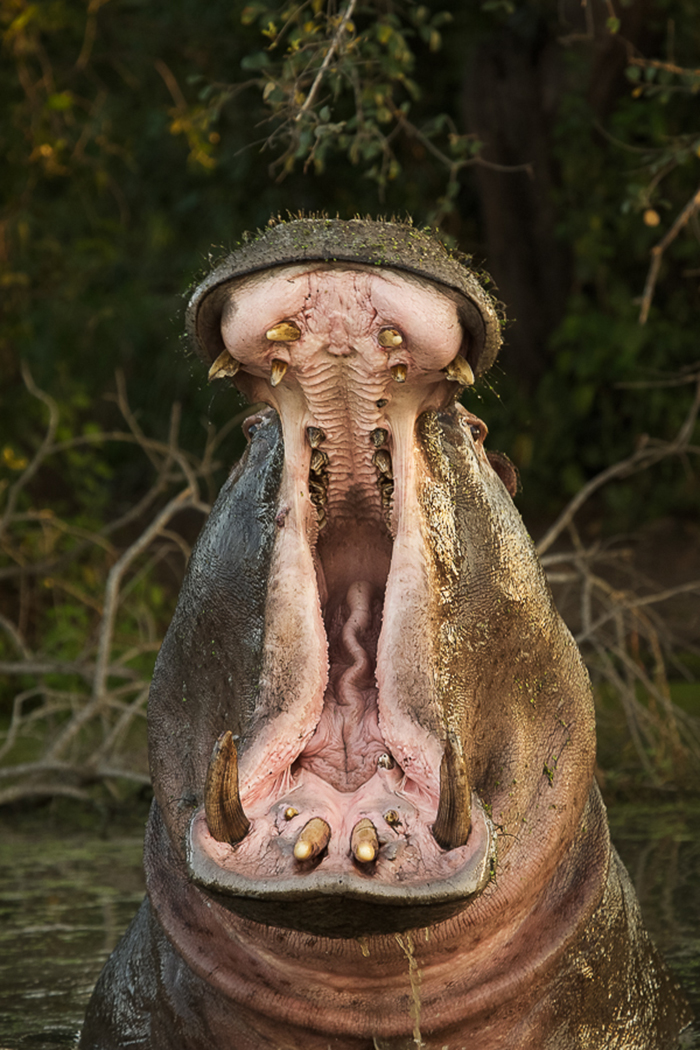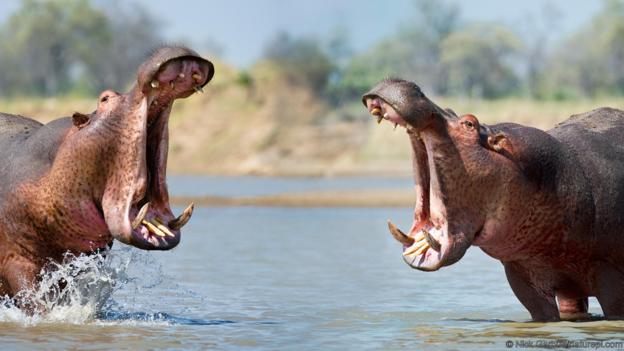1. Hippos Sweat Over Blood
Early roman naturalist Pliny the Elder was one of the first to notice a red secretion from hippos and suggested that hippos, which he described as being “over-gross and fat” were pricking themselves on sharp reeds, causing them to bleed and relieve their bodies from the swelling. Fortunately for us, a substantial amount of research has since been done on this substance that hippos secrete and the purpose it serves. Researchers have shown that what hippos actually secrete is a type of red gel secreted from glands under the skin. This substance helps to keep the skin soft and pliable and could even shield hippos from the harsh sun. Hippos constantly fight, particularly bulls, which often results in gaping wounds; the substance in question also has antibiotic properties which could help heal these wounds. But here’s where things get interesting. When this substance is initially secreted it is clear, very much the same colour of human sweat, but when exposed to sun for a long time it takes on an orange-brown hue, which is probably what early naturalists interpreted as blood.

A pod of hippos lay up next to a crocodile on the bank of a waterhole. During stressful times, hippo will secrete a reddish substance from their skin which helps to keep the skin soft and pliable, and also has antibiotic properties.
2. Hippos Stamp Out Camp Fires
In certain parts of Africa, folklore abounds about hippos running through campsites, trampling out campfires and knocking supplies about. Although hippos have almost certainly run through some campsites and stamped out fires, whether this was intentional could simply be a misinterpretation. Explorers and hunters would often set up camp close to water in the early pioneering days and run-ins with hippo could have been related to this. Camping close to water was not only convenient for the pioneers, but setting up camp was easy due to open clearings and prominent pathways created by hippos that venture out of the water each evening to forage. Hippos that encountered these campfires most likely trampled them in an attempt to run back to the water, which they would consider to be their safe refuge.

In the early pioneering days, camp sites were often made close to water for convenience and in open clearings close to prominent hippo paths. This could explain tales of hippos stamping out campfires.
3. Hippos Are Good Swimmers
Although hippos can spend almost 16 hours a day submerged in water, they cannot swim. At least, not as we consider it. Hippos lack webbing on their feet and have short stumpy tails, neither of which are adapted for swimming. Instead, hippos are bottom dwellers, walking along the river bed while keeping their nostrils above water to breathe. Although they can hold their breath for about five minutes, when hippos reach deep sections of a river, they will often “hop” along the bottom until they reach a section of river shallow enough to rest up in. Hippos are a vital species in river and waterholes, opening up water channels that would otherwise become clogged with reeds, and churning up silt that would otherwise collect at the bottom of deep pools. This silt contains vital nutrients that support a myriad of other life forms such as snails and insects, which in turn feeds a multitude of other animals.

A marsh terrapin rests on the back of a hippo. Hippo dung releases nutrients into deep pools, sustaining a variety of other lifeforms such as insects and crustaceans, which this terrapin will eat.
4. Hippos Eat Meat
When a hippo opens its mouth the incredibly large canines and incisors could easily give the impression that these animals should be carnivorous in some way or another. It does actually happen that hippos occasionally scavenge meat. However, these large teeth are usually used for self defense. Hippos are almost exclusively vegetarians, coming out at night time to feed on around 30 kg of grass in an evening and returning to the water before sunrise. The large teeth play no role in cropping grass, which is plucked off using the very broad lips. As a result of the recent El Nino, we had lower than average rainfall and as a result, grass cover has been limited in some areas. The hippos are adapting to it, venturing further in the evenings to feed. In fact, when food is scarce, hippos can even cover distances of up to 10 km or more in search of grass.

A hippo opens its mouth, displaying its impressive canines and incisors which are used mostly for fighting and self defense. The molars seen toward the back of the mouth are used to grind down grass cropped up by the lips.
5. Hippos are the Most Dangerous Animals in Africa
Hippos are often described as the most dangerous animal in Africa, and based on the figures of human fatalities, this statement is true (approx 2,900 deaths per year!). Hippos should certainly never be underestimated and have the potential to be extremely dangerous. However, the fact that hippos come into contact with humans more than any other animal in Africa has a lot more to do with where hippos live, rather than them being bad tempered, aggressive animals. Throughout Africa, hippos live in large rivers and permanent water sources both inside of and out of conservation areas.
Many rural people, who live in these same areas are dependent on the same rivers that many hippos call home. On a daily basis people walk from their villages to rivers and waterholes to wash their clothes and collect water for drinking and crops. On many occasions people walk down the well defined pathways created by hippos previously discussed. When confronted by humans, a hippo will almost always attempt to move back to the safety of the water, which can often be tragic if the bystander is blocking the hippo’s immediate pathway.

Dawn on the Sand river. Africa’s rivers are home to hippos, but they are also the lifeblood of many rural villages, where locals venture to rivers to collect water on a daily basis. As a result, humans come into contact with hippos more often than most animals.

Rich Laburn is filmmaker, photographer and writer who is based at Londolozi Game Reserve in South Africa. Spending his time capturing scenes of the wild and communicating the beauty of the African bushveld, he runs the Londolozi Blog as a way to entertain and engage people wishing to visit these wild lands.









